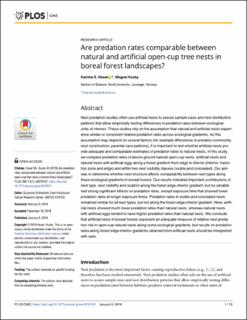| dc.contributor.author | Hoset, Katrine S. | |
| dc.contributor.author | Husby, Magne | |
| dc.date.accessioned | 2020-06-11T12:58:30Z | |
| dc.date.available | 2020-06-11T12:58:30Z | |
| dc.date.created | 2019-01-28T14:17:40Z | |
| dc.date.issued | 2019 | |
| dc.identifier.citation | Hoset, K. S., Husby, M. (2019). Are predation rates comparable between natural and artificial open-cup tree nests in boreal forest landscapes? PLOS ONE, 14(1): e0210151. doi: | en_US |
| dc.identifier.issn | 1932-6203 | |
| dc.identifier.uri | https://hdl.handle.net/11250/2657731 | |
| dc.description.abstract | Nest predation studies often use artificial nests to secure sample sizes and nest distribution patterns that allow empirically testing differences in predation rates between ecological units of interest. These studies rely on the assumption that natural and artificial nests experience similar or consistent relative predation rates across ecological gradients. As this assumption may depend on several factors (for example differences in predator community, nest construction, parental care patterns), it is important to test whether artificial nests provide adequate and comparable estimates of predation rates to natural nests. In this study, we compare predation rates of above-ground natural open-cup nests, artificial nests and natural nests with artificial eggs along a forest gradient from edge to interior (interior, transition zone and edge) and within two nest visibility classes (visible and concealed). Our aim was to determine whether nest structure affects comparability between nest types along these ecological gradients in boreal forests. Our results indicated important contributions of nest type, nest visibility and location along the forest edge-interior gradient, but no variable had strong significant effects on predation rates, except exposure time that showed lower predation rates at longer exposure times. Predation rates in visible and concealed nests remained similar for all nest types, but not along the forest edge-interior gradient. Here, artificial nests showed much lower predation rates than natural nests, whereas natural nests with artificial eggs tended to have higher predation rates than natural nests. We conclude that artificial nests in boreal forests represent an adequate measure of relative nest predation risk in open-cup natural nests along some ecological gradients, but results on predation rates along forest edge-interior gradients obtained from artificial nests should be interpreted with care. | en_US |
| dc.language.iso | eng | en_US |
| dc.publisher | Public Library of Science | en_US |
| dc.rights | Navngivelse 4.0 Internasjonal | * |
| dc.rights.uri | http://creativecommons.org/licenses/by/4.0/deed.no | * |
| dc.title | Are predation rates comparable between natural and artificial open-cup tree nests in boreal forest landscapes? | en_US |
| dc.type | Peer reviewed | en_US |
| dc.type | Journal article | en_US |
| dc.description.version | publishedVersion | en_US |
| dc.rights.holder | © 2019 The Author(s) | en_US |
| dc.subject.nsi | VDP::Matematikk og Naturvitenskap: 400::Zoologiske og botaniske fag: 480::Økologi: 488 | en_US |
| dc.subject.nsi | VDP::Matematikk og Naturvitenskap: 400::Zoologiske og botaniske fag: 480::Etologi: 485 | en_US |
| dc.source.pagenumber | 15 | en_US |
| dc.source.volume | 14 | en_US |
| dc.source.journal | PLOS ONE | en_US |
| dc.source.issue | 1 | en_US |
| dc.identifier.doi | 10.1371/journal.pone.0210151 | |
| dc.identifier.cristin | 1666486 | |

